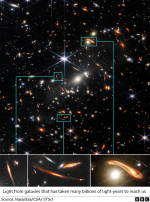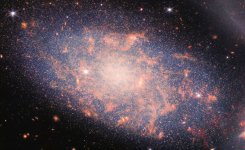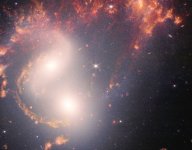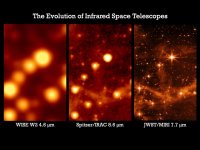I simply picked the feed up from my phone.Well, it's at the horses mouth... No need for apple news....
😊
Yeah, sorry... A poor attempt on my part at an apple dig... 🙂
Wonderful images though, wherever you see 'em...
Best quality uncompressed images are here though:
https://www.nasa.gov/webbfirstimages
Wonderful images though, wherever you see 'em...
Best quality uncompressed images are here though:
https://www.nasa.gov/webbfirstimages
Not sure what you mean by blurry. I clicked through and got to this image bigger-than-my-screen because of the large number of pixels:
https://www.nasa.gov/sites/default/...ar-forming_region_carina_nircam_final-5mb.jpg
The stars and such all look in focus. If you mean the bluish haze in some areas of the top third, that's presumably interstellar gas or some such, not a lack of focus.
https://www.nasa.gov/sites/default/...ar-forming_region_carina_nircam_final-5mb.jpg
The stars and such all look in focus. If you mean the bluish haze in some areas of the top third, that's presumably interstellar gas or some such, not a lack of focus.
sheesh, you really don't want to do any of the work.
Ok couple of zoom ins of stephan's quintet. First one is a galaxy 40 million light years away and you can see individual stars. Second one is 290 Million light years away and also looks pretty sharp. Please not much of the universe is composed of clouds of gas.
Ok couple of zoom ins of stephan's quintet. First one is a galaxy 40 million light years away and you can see individual stars. Second one is 290 Million light years away and also looks pretty sharp. Please not much of the universe is composed of clouds of gas.
Attachments
Not sure what you mean by "any of the work". NASA's own images are what I'm referring to. Does it get any better than that? Maybe it's just my laptop, MacBook Pro 13"? Or I'm just expecting too much? Even that first image is "good" imo, not great. Please keep in mind I'm not referring to the content or resolution, only focus/sharpness although it may be related to resolution? Hubble has much sharper images imo.sheesh, you really don't want to do any of the work.
Ok couple of zoom ins of stephan's quintet. First one is a galaxy 40 million light years away and you can see individual stars. Second one is 290 Million light years away and also looks pretty sharp. Please not much of the universe is composed of clouds of gas.
Angular resolution is the term astronomers use to describe the "sharpness" of an image.
There are two factors that affect how sharp an image is - the diameter of the mirror and the wavelength being observed.
If you do the maths, this means that Webb has the same angular resolution at 2000 nm (infrared light) as Hubble has at 700 nm (red light).
Consequently, Webb images are comparable in sharpness to Hubble images.
Where the JWST has the advantage is in its ability to peer through cosmic dust, look further back in time than Hubble and see objects that are 10 to 100 times fainter than Hubble can see.
There are two factors that affect how sharp an image is - the diameter of the mirror and the wavelength being observed.
If you do the maths, this means that Webb has the same angular resolution at 2000 nm (infrared light) as Hubble has at 700 nm (red light).
Consequently, Webb images are comparable in sharpness to Hubble images.
Where the JWST has the advantage is in its ability to peer through cosmic dust, look further back in time than Hubble and see objects that are 10 to 100 times fainter than Hubble can see.
https://webbtelescope.org/
Go to images, download PNG or TIF. Should be the highest resolution.
Zoom in on downloaded image.
Go to images, download PNG or TIF. Should be the highest resolution.
Zoom in on downloaded image.
The more you zoom in, the grainier and blurrier it gets. Don't know why you guys aren't acknowledging this, it's very obvious.
btw, after looking at Hubble's again, I'd say the same thing but I would still say Hubble's are a bit better.
btw, after looking at Hubble's again, I'd say the same thing but I would still say Hubble's are a bit better.
when you pixel peek an image you will see blur and grain. It's normal. Were you expecting hollywood CGI images or something. For reference here's a repost of the pic of what the previous best IR cameras could see.
https://newatlas.com/space/james-webb-vs-hubble-side-by-comparison-images/ side by side hubble vs webb showing the differences that can be seen with the longer wavelengths.
https://newatlas.com/space/james-webb-vs-hubble-side-by-comparison-images/ side by side hubble vs webb showing the differences that can be seen with the longer wavelengths.
Attachments
There can be no argument that there is a limit to the angular resolution of the JWST.
The Webb can resolve a football at a distance of 340 miles.
Obviously, if the football were more distant than that, its image would be blurred.
The Webb can resolve a football at a distance of 340 miles.
Obviously, if the football were more distant than that, its image would be blurred.
when you pixel peek an image you will see blur and grain. It's normal. Were you expecting hollywood CGI images or something. For reference here's a repost of the pic of what the previous best IR cameras could see.
https://newatlas.com/space/james-webb-vs-hubble-side-by-comparison-images/ side by side hubble vs webb showing the differences that can be seen with the longer wavelengths.
I've done alot of astronomic imaging but specifically high resolution information recovery using a 4" refractor in the back garden:
Those four dots are the sensor pixel sizes. Which means that's 28 arc seconds across.
The bear paw:
Compared to my 4" image above, this is what a space telescope sees: https://en.wikipedia.org/wiki/NGC_2537
And to show post processing - before:
After:
Enough to say - JWT is exceptional but for the most part just the visible wavelength is actually the less impressive stuff. Far more is the capability of the spectrographs. I built a DIY spectroscope for sun hydrogen alpha and got a resolution R6000 and bandwidth of 0.9Angstroms according to one of the professionals analysing my sodium test image. That's enough to be able show the movement red shift in hydrogen gas as it moves on the sun.
JWST's is far better: https://www.cosmos.esa.int/web/jwst-nirspec/nirspec-performances
It can be a subtle bang. You never know.
Like a comedy "Pop!" ? 😀
- Status
- Not open for further replies.
- Home
- Member Areas
- The Lounge
- What is the Universe expanding into..



